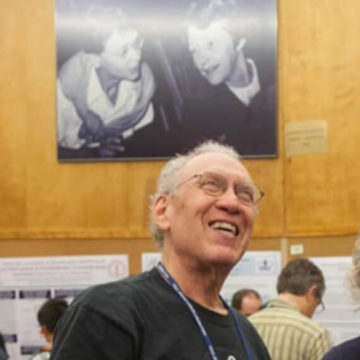
Cell Biology
James E. Haber
Specially Appointed Professor
Chromosome dynamicshomologous recombinationDNA double strand break repair
Biography
James E. Haber received his PhD in Biochemistry at the University of California, Berkeley. After postdoctoral work at the University of Wisconsin, Madison, he joined the Department of Biology at Brandeis University in 1972. He is now the Abraham and Etta Goodman Professor of Biology and Director of the Rosenstiel Basic Medical Sciences Research Center. He has focused his research on genome instability, especially the repair of chromosome double-strand DNA breaks and the role of DNA damage checkpoints. In 2011 he received the Genetics Society of America’s Thomas Hunt Morgan Medal for Lifetime Achievement in Genetics. He is a member of the National Academy of Sciences, and a Fellow of the American Association for the Advancement of Science, the American Academy of Microbiology and the American Academy of Arts and Sciences.
Expectations for WRHI
I have the opportunity to work closely with Professor Hiroshi Iwasaki and the talented members of his laboratory on questions of how broken chromosomes are repaired by cells. My visits also enable me to come in contact with other Japanese researchers in Tokyo and other major research centers in Japan.
Research Projects
-
DNA damage response and repair of a broken chromosome
National Institute of Genreral Medical Sciences
(2018-2023)The overall goal of NIGMS-funded research in my lab is to describe the molecular and cellular mechanisms by which cells sense the presence of DNA damage and carry our repair of chromosomal double-strand breaks (DSBs). Using budding yeast as a model system, it is possible to induce site-specific DSBs with a high degree of synchrony not yet possible in mammalian cells, allowing “in vivo biochemistry” approaches to monitor intermediate steps in DSB repair and DNA damage signaling. We investigate key questions concerning DSB repair by homologous recombination. We seek to understand what is the basis of the 1000-fold increase in mutations associated with DSB repair and how microhomologies are used in repair-dependent template switching, creating complex chromosome rearrangements analogous to events recently found in human cancers. Finally, we wish to understand how the DNA damage checkpoint and DNA damage-induced autophagy are regulated. These studies will provide new insights and guidance in defining the DSB repair and checkpoint signaling in human cells.
Jenny Choi
Danielle Gallagher
Brenda Lemos
Kevin Li
Yuko Nakajima
Elena Sapede
Neal Sugawara
Miyuki Yamaguchi
David Waterman
Judy Qiuqin Wu
Felix Zhou
| 1972-1977 | Assistant Professor, Brandeis University |
|---|---|
| 1977-1984 | Associate Professor, Brandeis University |
| 1984- | Professor, Brandeis University |
| 2017- | Specially Appointed Professor, Tokyo Institute of Technology |
| 1996 | Fellow, American Academy of Microbiology |
|---|---|
| 2005 | Fellow, American Association for the Advancement of Science |
| 2007 | NIH MERIT award |
| 2008 | Fellow, Radcliffe Institute of Advanced Study |
| 2009 | Member, American Academy of Arts and Sciences |
| 2010 | Member, National Academy of Sciences |
| 2011 | Thomas Hunt Morgan Medal for Lifetime Achievement in Genetics, Genetics Society of America |
| 2001 | Valencia MM, Bentele MB, Vaze MG, Herrmann E, Kraus, Lee SE, Schar P and Haber JE. (2001) NEJ1 controls non-homologous end joining in Saccharomyces cerevisiae. Nature414, 666-9.
|
|---|---|
| 2003 | Ira G, Malkova, A, Liberi G, Foiani M, and Haber JE. (2003) Srs2 and Sgs1-Top3 Suppress Crossovers during Double-Strand Break Repair in Yeast. Cell 115, 401-411. |
| 2007 | Lydeard JR, Jain S, Yamaguchi M and Haber JE. (2007). Break-induced replication and telomerase-independent telomere maintenance require Pol32. Nature 448, 820-823. |
| 2010 | Hicks WM, Kim M and Haber JE. (2010) Increased mutagenesis and unique mutation signature associated with mitotic gene conversion. Science 329, 82-85. |
| 2014 | Tsaponina O and Haber JE. (2014) Frequent Interchromosomal Template Switches during Gene Conversion in S. cerevisiae. Mol Cell 55, 615-625. Lee CS, Lee K, Legube G and Haber JE. (2014) Dynamics of yeast histone H2A and H2B phosphorylation in response to a double-strand break. Nat Struct Mol Biol. 21, 103-109. |
| 2016 | Tsabar M, Waterman DP, Aguilar F, Katsnelson L, Eapen VV, Memisoglu G, Haber JE. (2016). Asf1 facilitates dephosphorylation of Rad53 after DNA double-strand break repair. Genes Dev. 30, 1211-24. |
| 2017 | Anand R, Beach A, Li K and Haber JE (2017) Rad51-mediated double-strand break repair and mismatch correction of divergent substrates. Nature 544, 377–380 |
| 2018 | New insights into donor directionality of mating-type switching in Schizosaccharomyces pombe. Takahisa Maki, Naoto Ogura, James E Haber, Hiroshi Iwasaki, Genevieve Thon. PLoS Genet. (2018) 14(5):e1007424. |
